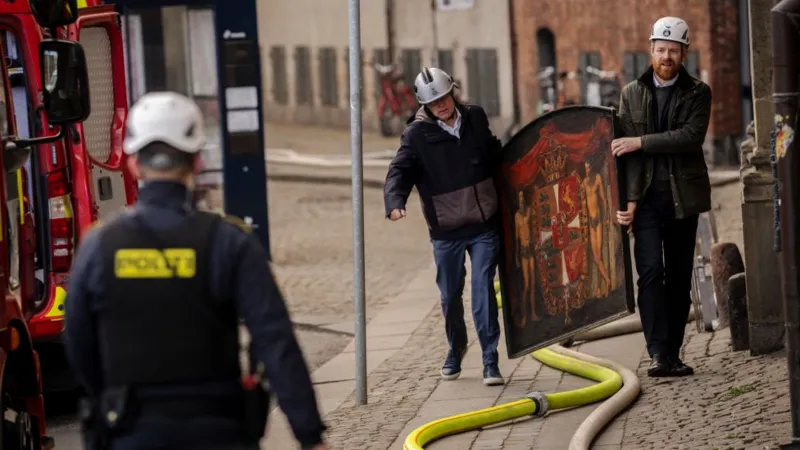Børsen fire: Denmark endures its own Notre Dame devastation
Alarm bells first rang out early on Tuesday morning as fire ripped through Copenhagen's historic former stock exchange building, Børsen.

Within no time at all the inferno had gutted large parts of the 400-year-old structure and toppled the ornate spire known for its distinctive dragons.
Brian Mikkelsen, who heads the Danish Chamber of Commerce which owns Børsen, has vowed that it will be rebuilt "no matter what".
Comparisons have been drawn with France's Notre-Dame cathedral, which was devastated by fire in 2019.
Danish officials now hope to find out what lessons can be learned from the cathedral's swift restoration.
Mr Mikkelsen was cycling to his office when he first heard about the fire and arrived to find scores of firefighters tackling the blaze.
"I was biking in there. Then I saw the flames," he said.
Together with colleagues and emergency workers, he ran into the burning building multiple times to rescue some of the hundreds of centuries-old artworks stored inside.
"We'd been running, in and out, in and out. Sometimes the fire team said we should get out because we were right next to the fire," he recalled.
"I didn't think, I just reacted. It was intuition saying that we have to save this."
About 100 soldiers were brought in to help the rescue effort, climbing on each other's shoulders to pull down artworks mounted high up on the walls.
Except for a bust of King Christian IV of Denmark that weighed two tonnes, most of the historic items were recovered.
"We got almost everything," Mr Mikkelsen told me. "So that's a little hope in disaster."
Fortuitously the spire's ornamental metal tip also survived and was handed over to him.
"It is one of the worst days of my life," he reflected. "It's really a disaster for history and for culture."
Watching in horror
Danes have been shocked and saddened by the loss of the famous dragon spire from the city's picture postcard skyline.
It is a sight that many regularly walk or cycle past, and there has been a public outpouring of support with people sharing photos of Børsen on social media.
Resident Cheri Christiansen told me that seeing it burn down was emotional.
"I have a full view over the city and I could see the flames. I burst into tears, because it's our heritage," she said, adding: "It's never going to be the same. But I hope they can rebuild it."
"It was a very sad feeling because it is a very historical building," said another resident, Mohamed Ibrahim Zaid.
"I could see it from my apartment. It was devastating to watch," agreed Viktor Stabel Øvro, who also lives nearby.
"I hope they will reconstruct it, just as it was before."
Neighbouring the Danish parliament, Børsen was built in 1625, by Christian IV, who was one of the country's most powerful monarchs, as a trading hub for Northern Europe.
With its red bricks, teal-green copper roof and richly decorated interior, it was one of the few Renaissance buildings left in Copenhagen.
Outside parliament MP Henrik Moeller told me: "I think it's part of both Copenhagen and Denmark's identity. It was a very iconic building."
"Of course there are comparisons with Notre-Dame. It's kind of the Danish Notre-Dame that we have experienced here."
France's famous cathedral was devastated by fire in 2019, and is due to reopen again this December, following just five and a half years of restoration work, while the immediate vicinity around it will be redeveloped by 2028.
Copenhagen's Mayor Sophie Hæstorp Andersen told the BBC it was terrible to see 400 years of Danish history go up in flames.
"We have just lost a fundamental part of the city's soul and history," she said.
Ms Andersen is among those rallying to see Børsen rebuilt and has spoken with the Mayor of Paris, Anne Hidalgo, to hear about Notre-Dame's restoration.
A team from Denmark is scheduled to visit the cathedral next month.
Rapid spread
From the nearby square outside parliament, I spent Tuesday observing the orange flames and the billowing smoke that engulfed the stock exchange as several fire crews armed with hoses battled the blaze.
Around 300 emergency workers were involved in the enormous operation.
You only see an incident like this once or twice in your career, Copenhagen's emergency services chief of operations Tim Ole Simonsen told the BBC.
"The fire was very intense in the beginning, spreading rapidly inside and outside," he said.
The first images from inside showed torched and waterlogged rooms, strewn with charred timber and black ash.
Twisted scaffolding now stands precariously and large sections of the outer wall have collapsed, while 40 shipping containers filled with concrete have been placed around the ruins as supports.
"The walls are now very unstable," said Mr Simonsen, adding that extreme changes in temperature, drying and water saturation had weakened the structure.
Pockets of smouldering embers continue to burn and on Thursday I could still see smoke.
"There's still a lot of minor fires in the rest of the building," Mr Simonsen said.
It is unclear when it might be fully extinguished, he added.
"There will be a lot of work until Monday morning, and then there'll be a review," he said.
Police have said it could take months to determine the cause of the fire.
Renovation work had been taking place over the last two years, readying for Børsen's 400th anniversary celebrations this autumn.
Initial theories suggested the fire might have started in the roof area. But given how rapidly it spread, some fire experts think it may have begun earlier.
"My best guess would be that there has been a smouldering fire inside a cavity from the night before," Jens Kastvig, a fire adviser at Copenhagen Fire Engineering, told Danish national broadcaster DR.
The architect behind the restoration, Leif Hansen, told Danish newspaper Politiken that all the work had been lost, but he believed Børsen should be rebuilt.
"It has to be and we can do it," he said.
Prime Minister Mette Frederiksen visited the site on Friday, thanking firefighters and voicing her support for the reconstruction.
Mr Mikkelsen has ruled out a modern design and wants to see it remain faithful to the original.
"For me, the vision is that we will built it like Christian IV built it," he said.
The work is expected to cost well over 1bn kroner (£115m; $143m). How that will paid for is yet to be determined and an insurance assessment is pending.
However some of Denmark's largest foundations and companies have already pledged large donations and the public response has been overwhelming, Mr Mikkelsen said.
"I have never in my life felt so much love from ordinary Danes. I've got a thousand emails," he added.
-bbc







